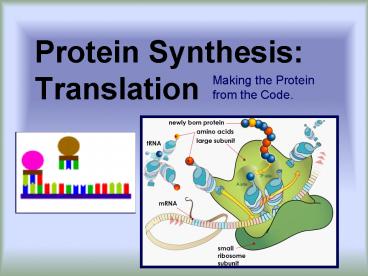Protein Synthesis: Translation - PowerPoint PPT Presentation
1 / 22
Title:
Protein Synthesis: Translation
Description:
The tRNA with the anticodon UAC carries the amino acid methionine. 3) ... The polypeptide chain may be modified so that it can function properly. – PowerPoint PPT presentation
Number of Views:74
Avg rating:3.0/5.0
Title: Protein Synthesis: Translation
1
Protein Synthesis Translation
Making the Protein from the Code.
2
Overview of Translation
- 1) Messenger RNA moves from the nucleus to the
cytoplasm and attaches to the ribosome.
3
- 2) As the ribosome moves along the, mRNA, tRNAs
with their anticodons (matching the mRNA codons)
carry the proper amino acids to the ribosomes. - The first codon is the start
- codon (AUG). The tRNA
- with the anticodon UAC
- carries the amino acid
- methionine.
4
- 3) As two amino acids are brought side-by-side,
they bond by a condensation reaction (dehydration
synthesis).
Bond
5
- 4) The tRNA that held the first amino acid
leaves.
Bond
6
- The ribosome continues to move along the mRNA,
while a new tRNA brings the next amino acid into
place. - 6) This continues
until the
stop
codon is
reached. - (The protein is
then processed
for use in, or out
of the cell.)
stop codon
7
Translation Animation
8
A More Detailed Look at Translation
9
Steps in Translation
- Initiation
- Elongation
- Termination
10
The Ribosome Binding sites
- There are three
binding sites on
the ribosome - One holds mRNA
so codons are
accessible. - The other two
hold tRNAs.
11
- The binding sites that hold tRNAs are the A
site and the P site.
12
Initiation
- 1) The smaller ribosome unit attaches to the mRNA
strand (at the methyl guanine MG cap.) - Many ribosomes may bond to the same mRNA. This
is called a polysome.)
13
- 2) The first tRNA attaches at the start codon.
Its three-base anticodon matches the mRNA codon.
At the other end is the attachment point for the
Amino acid.
14
- 3) A transfer RNA with an amino acid is called a
charged tRNA. (An enzyme and ATP bind to the
correct amino acid to the transfer RNA molecule.
At that point it is ready to carry the amino acid
to its correct place in the growing polypeptide
chain.)
15
- 4) The larger ribosome subunit attaches to the
smaller one (with the energy from GTP or
guanosine triphosphate). The Ribosome is complete
at this point and protein synthesis can proceed.
16
Elongation
- 1) The amino acid-charged tRNA that corresponds
to the next mRNA codon binds to the A site on the
ribosome. - 2) A peptide bond forms between two adjacent
amino acids. (condensation reaction)
17
- 3) The ribosome moves along the mRNA and the
process continues. The previous tRNA leaves. - The ribosome moves along so that the next tRNA
has now moved from the A to the P site. Another
charges tRNA brings an amino acid to the growing
protein chain.
18
Termination
- 1) Elongation continues until
the stop codon is
reached. - 2) A special protein binds to
the stop codon
at the A site. - 3) The newly-formed polypeptide is released. The
tRNAs are released. The two ribosome subunits
separate.
19
Translation Animation
20
Translation Animation
21
Where do the Proteins Go?
- Proteins formed at the ribosomes, free in the
cytosol, are used within the cell. - Proteins formed at the R.E.R. (rough endoplasmic
reticulum) are transported out of the cell.
22
Transport and Modification
- The first few amino acids provide the direction
that proteins will travel within the cell. It is
known as the signal sequence. - The polypeptide chain may be modified so that it
can function properly. It may be cut into smaller
segments, or a portion may be removed with
special enzymes.































